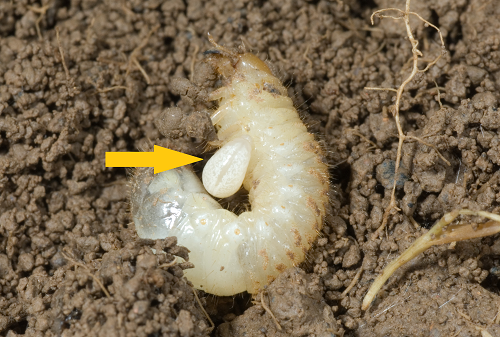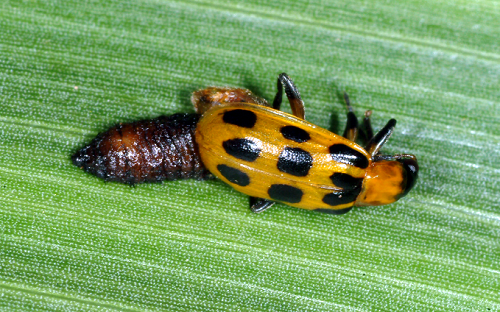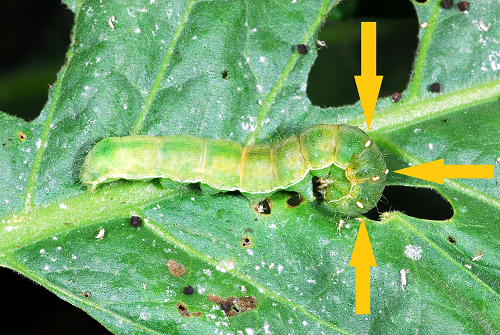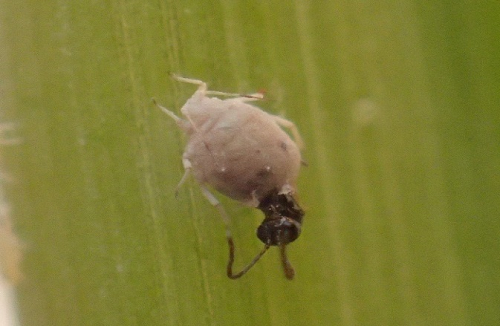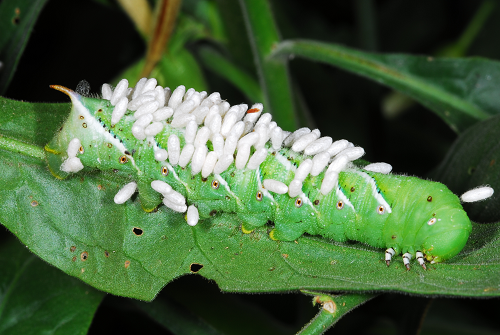Insect Parasitoids: Important Natural Enemies of Pests
ENTFACT-018: Insect Parasitoids: Important Natural Enemies of Pests | Download PDF
by Nathan Mercer, Laboratory Technician
University of Kentucky College of Agriculture
Parasitoids are a diverse group of insects that provide biological control of pests in your garden, greenhouses or crop fields. A parasitoid is an organism that spends its larval stage in or on another organism, also known as a host. The larval parasitoid feeds only on the host as it develops, eventually killing the host. Host death is what makes parasitoids different from other parasites, who do not necessarily kill their host, such as ticks or lice. The adult parasitoid leaves the host to find mates and new hosts to lay her eggs. Developing in or on a host requires the parasitoid to have very specialized methods to attack, feed on and avoid the host’s immune system This high level of specialization means most parasitoids only attack one or a few closely related species.
Figure 1. A Japanese beetle grub with an external Tiphia larval parasitoid (yellow arrow). Credit R. Bessin
Figure 2 Parasitoid pupa emerging from a spotted cucumber beetle. Credit R. Bessin
Wasps and flies contain the vast majority of insect parasitoids. There are over 70,000 parasitoid species across the globe. The word “wasps” generally brings to mind yellow-jackets or hornets, but most wasp species are in fact parasitoids, ranging in shape and size from small 0.008 inch fairyflies (who are wasps) to the five inch long Megarhyssa wasps.
Parasitoids attack all life stages of arthropods and employ a wide range of strategies to get their eggs on or in the host. Most wasps will use their ovipositor to insert their eggs either in or on their prey (Figure 3). Parasitoid flies lack an ovipositor capable of piercing their host’s exterior, instead they either glue their eggs onto the host or lay eggs on plants eaten by their host. Eggs eaten by the correct host insect then hatch in the host’s gut. Parasitoids are very specific to the life stage of hosts they attack. Even if other life stages of the host are present, the adult parasitoid will likely not even consider them as a potential host for her eggs.
Figure 3. A tobacco budworm with 4 fly eggs glued to its thorax (yellow arrows). Credit R. Bessin
Figure 4. An Aphidius parasitoid emerges from an aphid mummy.
Parasitoids may lay one to several eggs within a host and eggs can develop into one or multiple larvae. Once inside the parasitoid consumes the host and develop through instars much like any other insect would. If you were to open up a parasitized insect, the larvae would resemble a maggot. Once parastitization has begun, the infected host does not die right away and may continue to move and feed. This is different from predators who kill and directly consume their prey. Larval parasitoids only consume one host during their development, and do not travel to find more. This is true even if many parasitoid larvae are feeding on one host. Once the larval parasitoid is ready to pupate, there may be noticeable changes to the host. In the case of aphids, they turn into a mummy, due to the tan papery exterior that develops (Figure 4). Other parasitoid species may form pupal cases on the exterior of the host (Figure 5).
Notable parasitoids in our area include:
- The fly Trichopoda pennipes attacks squash bugs and stink bugs.
- Cotesia wasps attack tobacco horn worm (Figure 5).
- Tiphia wasps attacks white grubs (Figure 1).
Parasitoids perform an important ecosystem service by suppressing pest populations. The majority of pests are attacked by at least one parasitoid. There are three ways to improve pest suppression by parasitoids. The first is to limit insecticides use as much as possible. Insecticides are often toxic to many other beneficial insects. Using insecticides only when necessary based on scouting will greatly benefit parasitoids in your farm and garden.
Figure 5. A tobacco hornworm that has been killed by Cotesia larvae which have pupated outside the host. Credit R. Bessin
The second method is by improving the local plant habitat for parasitoids. Adult parasitoids require more than just hosts. Nectar is often an important food for adult parasitoids. Specific flower species that benefit parasitoids are not well established. Planting a variety of flowers is known to increase the local parasitoid population.
The third method is to increase parasitoid abundance with augmentative releases, or augmentative biological control. Increasing the local parasitoid population in this manner is helpful if the local population does not provide adequate pest control. A non-exhaustive list of vendors who sell natural enemies can be found in ENTFact 124, “Vendors of Microbial and Botanical Insecticides and Insect Monitoring Devices” (https:/ef124). Parasitoid releases are unlikely to produce desired results if they are used in a corrective manner, like insecticides. Success with parasitoid releases is highest if done when pest densities are low. There will be a delay of a few days between releases and noticeable decreases in pest densities. Parasitoids are shipped as pupae and can be dispersed once they have arrived. The adults emerge soon after and can begin to attack their hosts in as little as a few hours. Multiple releases may be required to produce adequate control. Follow supplier’s recommendation for storage and release of parasitoids. These methods work well when the pest is established and its parasitoids are either present locally or available for purchase. Dealing with invasive pests can be more complicated.
New invasive pests often have no parasitoids in their new habitat. In these cases, importation biological control can be used to bring natural enemies from the pest’s home range to its invasive range. Importation biological control is also called classical biological control. Importation biological control begins with a survey of the pest’s original habitat for natural enemies. Once identified, many tests are done to assess how well the natural enemy will perform in the new habitat. It is critical that the natural enemy is very host specific so that other insects will not be attacked as well. This makes parasitoids ideal for importation biological control due to their high host specificity.
Some examples of importation biological control are that can be found in Kentucky are:
- Alfalfa weevils’ populations are kept in check by several different imported wasp species that together attack all life stages of the weevil.
- Pea aphids have been successfully controlled by two wasps, Aphidius smithi and Aphidius ervi.
- Tetrastichus julis was imported and has provided significant control of cereal leaf beetle.
Further information on parasitoids can be found at University of California (http://ipm.ucanr.edu/PMG/NE/index.html) and Cornell University (https://biocontrol.entomology.cornell.edu/parasitoids.php)
CAUTION! Pesticide recommendations in this publication are registered for use in Kentucky, USA ONLY! The use of some products may not be legal in your state or country. Please check with your local county agent or regulatory official before using any pesticide mentioned in this publication.
Of course, ALWAYS READ AND FOLLOW LABEL DIRECTIONS FOR SAFE USE OF ANY PESTICIDE!
New: 8/20
